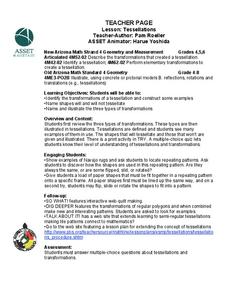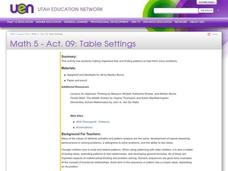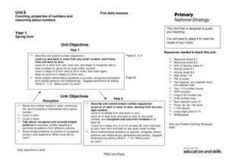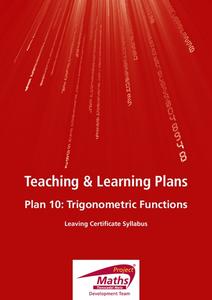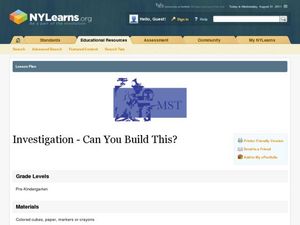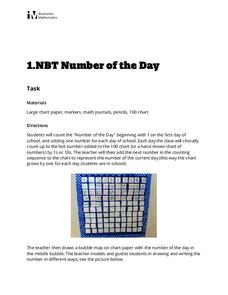Curated OER
Patterns in Dance
Third graders perform a line dance in the study of math as a pattern. They create and discuss movement solutions derived from movement exploration. They observe that patterns exist in the areas of music and dance and follow the...
Curated OER
Tessellations
Students form repeating patterns using tessellations. In this tessellations lesson, students identify shapes and illustrate three types of transformations. A website is included with the lesson which provides extension activities and...
Curated OER
Terrific Tessellations
Students create, transform, and critique their own piece of artwork. In doing this lesson, students get more experience working with angles, lines, and measurement. They gain experience seeing, and creating their own patterns and shapes.
Curated OER
Tessellations
Students create tessellations. In this math lesson, students explore symmetry and patterns through the creation of a tessellation. Students design and create their own tessellation.
Curated OER
Glad To Meet You
Students explore patterns. In this patterns instructional activity, students explore patterns in hand-shaking scenarios. Students work in groups to predict and record the number of handshakes that occur in a group.
Curated OER
Table Settings
Fifth graders explore and examine how to make organized lists and find patterns to help them solve problems. They identify, analyze and determine a rule for predicting and extending numerical patterns involving operations of whole...
Curated OER
Symmetry with Manipulatives
First graders investigate symmetry in patterns by utilizing unifix cubes. In this pattern lesson plan, 1st graders practice creating patterns that are perfectly symmetrical no matter which way it's looked at. Students utilize...
Curated OER
Seeing Double
Students develop an intuitive definition for symmetry after viewing a PBS video. They examine asymmetrical patterns and demonstrate their knowledge by changing them to symmytrical.
Curated OER
Keeping in Shape
Third graders describe patterns in terms of reflection and rotation symmetry, and translations. They design and make a pattern which involves translation, reflection, or rotation. They demonstrate why a given tessellation covers the...
Curated OER
Terrific Tessellations
Students construct tesselations that fosters their ability to create, transform, and critique their own piece of work. This allows them to become aware of repeated patterns in math, and connect these patterns to artwork.
Illustrative Mathematics
Seven to the What?!?
Sometimes what seems like the easiest problem is really the most difficult. Your class is first going to reach for their calculators, but will realize the number is too large to evaluate. Now what? This is where the fun and the...
Willow Tree
Line Plots
You can't see patterns in a jumble of numbers ... so organize them! Learners take a set of data and use a line plot to organize the numbers. From the line plot, they find minimum, maximum, mean, and make other conclusions about the...
Curated OER
Counting, Properties of Numbers, and Reasoning about Numbers
Five days of lessons develop number sense and counting patterns, including odd and even numbers, 5s and 10s, doubles, and ways to make 10. Each session opens with fun finger play to reinforce counting and reasoning about numbers. Various...
Project Maths
Trigonometric Functions
From a circle to a cycle! The final lesson of a five-part series challenges learners to use points from the unit circle to plot a repeating pattern. The repeating patterns become the graphs of the trigonometric functions. Scholars...
Curated OER
Investigating Square and Triangle Numbers
Fifth graders build increasingly larger squares and triangles using pattern blocks. They record the growth patterns on a chart and look for corresponding numerical patterns. Students describe the patterns they find and use them to...
Curated OER
Investigation--What's The Number?: Exponents
Eighth graders explore exponents and look for patterns that help to determine the ones place when the base is raised to any power. They use trial and error and seek general solutions. Also, identify patterns in a number sequence.
Curated OER
Multiplication
Students practice their multiplication facts by reinforcement and repetition. Students write facts in their math journals, and use labeled soccer ball and deck of cards to practice multiplying by "number of the day." Play continues until...
West Contra Costa Unified School District
Writing Exponential Functions Based on Data
Give your class a concrete example of exponential growth and decay using this hands-on activity. These Algebra II lessons allow for the exploration of exponential growth and decay models, as well as the discovery of the patterns of...
Curated OER
Equal Differences Over Equal Intervals 2
Your algebra learners explore linear functions concretely using tables of values in a collaborative task. The idea that linear function values change by equal differences over equal intervals, is emphasized. The slope and...
EngageNY
Graphing Cubic, Square Root, and Cube Root Functions
Is there a relationship between powers and roots? Here is a instructional activity that asks individuals to examine the graphical relationship. Pupils create a table of values and then graph a square root and quadratic equation. They...
Curated OER
Investigation--Can You Build This?
Early learners explore shapes using colored blocks. They first get some hands-on time with the blocks and then look at beginning math concepts regarding spatial relationships. They work with a partner to build a 6-8 block tower...
Illustrative Mathematics
Number of the Day
Daily routines not only help to manage classrooms, they can also provide students with rich opportunities for learning. This activity supports young learners in developing their number sense by counting up the school days on a class...
Illustrative Mathematics
Eight Circles
We are used to finding the area of a circle by plugging the radius into an equation. Here, learners are required to go further to find multiple areas and calculate the difference. They must detect a pattern in order to figure out the...
Mathematics Assessment Project
Discovering the Pythagorean Theorem
Young mathematicians join the ancient order of the Pythagoreans by completing an assessment task that asks them to find the area of tilted squares on dot paper. They then look at patterns in the squares to develop the...

